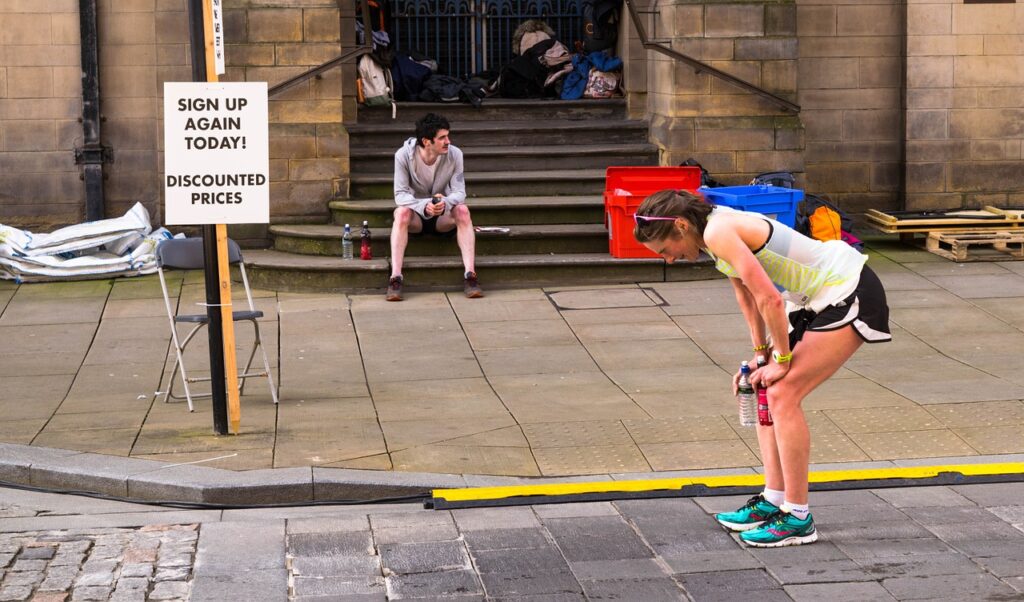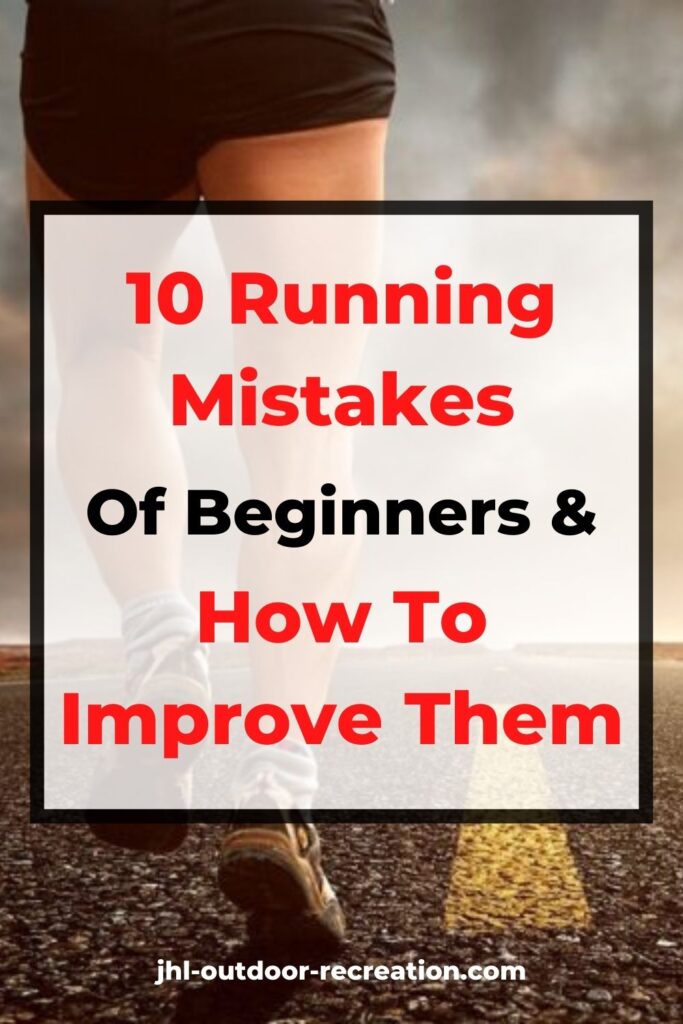Running is a simple and popular exercise. But, many beginners, even some experienced runners, may make some common running mistakes without noticing. – Does the below seem familiar to you?
You have finally made up your mind in getting serious into running. You ran a few times. But, you realized that your running sessions were disappointing, instead of enjoyable.
You observed the other runners. It seemed like they were “flying” and enjoying their run.
“Damn, how did they do this? I wish I could run like them.”
It is true that running is the simplest form of exercise because we just need our legs to run. But, efficient running is hard to achieve at the same time.
Take a look at ourselves. Mostly probably we make some common running mistakes which hinder us from running efficiently.
Here, I’m gonna show you top 10 common running mistakes that beginners make and how to fix them.
1. No warm up and warm down
This is one of the common running mistakes that runner alwaysssssssss overlook. Let’s face it. We all DID straight head to running because we were so excited about running without warming up. Worse still, we didn’t warm down our body after our running either.
Our strikes are heavy and tight without warming up. We feel stressed and we were getting out of breath easier. And, the worse thing is, we experience leg muscle pain and sometime we couldn’t even walk properly the next few days.
We always overlook the importance of warming up and warming down. But, in order to have injury-free and efficient running, we need to spend a few minutes each on the warming up and warming down sessions.
Stretch your body before and after your run. Stretch your arms, ankles and thighs, and twist your torso. You could also have slow jog between stretching and running.
Don’t think these are subtle. They can make a significant difference in the long run.
2. Improper clothing

So, you were surprised because you were sweating like a pig and you were soaked in the shirt. But, you realized that your shirt was made of cotton. After that, you noticed you were a stinky creature!
Or, you were shivering even if you’d run for long miles in winter.
Either one of these situations, you have UNCOMFORTABLE running. Most probably you are wearing improper clothing for running. In fact, there are two common factors to consider the proper clothing for running.
Fabric
Wearing cotton for running is a big NO NO! Cotton shirts trap heat and sweat and are terrible in drying.
So, shirts with fabric for running are ideal which don’t trap heat and sweat and are efficient in drying. Those clothing fabrics include
- Nylon
- Polyester
- Wool
- Polypropylene
- Bamboo
- Spandex
Temperature
Also, remember to wear proper clothing for the temperature. For example, wear light, such as T-shirt, short and socks, for running in warm or hot weather; wear pants, vest, or jacket in cold weather.
You don’t want to overdress and sweat excessively while running in a hot weather because you feel like you are being “cooked” under the sun. Similarly, you don’t want to underdress and keep shivering while running in the winter either. – Unless you want to take it as a specific training?
3. Improper footwear

When you are new to running, it is fine to wear any shoes. But, when you are into running and want to take it seriously, it’s time to consider investing in proper running shoes.
Improper footwear for running in the long run might cause ankle and knee injuries because of the inefficient absorption of force when running. Sometimes, your ankles will injure and bleed because of the constant friction with the improper footwear.
You look for the right size of the shoes before you buy them. So, it is no exception that you also need to look for the RIGHT footwear for running as well.
However, every person is unique, and you could see there are so many designs for running shoes. – So, how do we choose the right running shoes?
Generally, the shoes should be FIT and we feel COMFORTABLE when we are running. These are determined by the SHAPE of our feet and the WEIGHT of the shoes.
Firstly, see whether your feet are flat or arched and you choose the shoes accordingly.
Secondly, determine how thick the cushion you want to have for your running shoes. While cushion can help you absorb more shock while running, cushion also contributes to the weight of the shoes. – You need to strike a balance between comfortable and light running shoes.
4. Inefficient foot strike

When you run, most probably your heel will land on the ground first if you notice. This is HEEL strike – a very common strike of the runners.
Arguably, this is one of the common mistakes which is debatable. You have probably heard of the other types of strikes called FOREFOOT and MID-FOOT strikes.There is a long debate on which type of strike prevails and there is argument against the heel stride because it will cause knees injuries in the long run.
However, there are arguments against forefoot and mid-foot strike, too, as they will cause ankle injuries and Achilles tendon pain. And, heel strike is natural which you could see so many runners are having heel strike. – Well, is that true?
Why not try barefoot running? If you are running barefoot, you’ll notice it is very uncomfortable, and maybe painful, for heel strike. To counter this, you’ll notice you lean your body forward to shift the centre of gravity and eventually, you land forefoot or mid-foot.
However, the point here is not pointing that heel stride is incorrect, as the cushion of the running shoes provides comfort and which is why so many runners run on heel stride.
But, if you suffer pain or injuries because of your strike, you may want to consider learning other foot strikes.
5. Too soon, too much
Too soon
We always feel excited when we just start to run. Then, we are tempted to run fast TOO SOON because we are energized.
We are not out of breath yet, but we are actually wasting energy. Running is about preserving energy to run long distance. If energy is wasted, we will run out of breath TOO SOON and will get tired easily. – Guess what? We will be demotivated and frustrated.
The better way is to run at a comfortable pace without full force. You’ll be amazed that you are able to run much longer and more comfortable.
Too much
This is your first running session. You are excited and you feel great with a sense of achievement by running a long distance, say 10k, without any training or running background. – That is a GREAT day.
This is good. But, there is a catch. You’ll probably push yourself too hard on your first long distance running, and mentally you set a high expectation on yourself, even you know you need a lot of improvement on your technique.
But, what if the next day is a bad day? You don’t feel like running and you are only probably able to run a shorter distance, say 3km. How would you feel? – You can’t meet your expectation and you’ll probably feel deeply frustrated and judge yourself.
I knew the feeling. I experienced it and I avoided running because of this. What I suggest is don’t push yourself too hard at the beginning and gradually increase the mileage and intensity when your technique improves.
6. Run daily

Running is a very good exercise and theoretically you can run every day. – Many runners, especially elite runners, have daily running routine.
But, we can’t deny that our body needs time to recover. Imagine our legs sustains huge amount of force for a long run, what happens if we keep straining our legs daily? – You are at risk of injure your legs.
Mm…. If you don’t believe this, try to run long distance consecutively for a few days. You’ll notice your performance getting weaker and weaker. – This is a sign that you need some rests.
In fact, some suggest having alternate day running schedule. So, running 3 to 4 times per week alternatively is a great schedule which you could consider as a beginner.
On your non-running days, you could consider doing some cross trainings which train other parts of your body.
Or, you could set it as REST day which you don’t do any exercise at all. – Don’t feel guilty about this, because you are allowing your body to recover so you can run better next time.
7. Avoid interval running
What would you do to make sure you run longer? You’ll definitely run slower to preserve your energy. But, sometimes the quality of the run is compromised in order for us to run longer. – This gives a wrong perception that we achieve this yet our stamina is not improved.
That is the purpose of interval running. Interval running helps to improve our strength and stamina while altering the pattern of our running which stimulates our brain and muscle to work differently.
I feel bad actually. I always cheat on myself which non-stop running is good enough and tend to avoid interval running.
After I stop running, I don’t have the momentum to get back to my original running speed, and I will give myself tonnes of excuses of not doing interval running.
I hate the feeling where my heart needs to pump harder again and my legs need to stride harder to get back the cadence. – But, yeah, I have to face this and get back to interval running.
Interval running involves the combination of light jogs, regular running and sprinting for a set of time or distance respectively. For example, after you sprint for 200 metres, jogs lightly for another 200 metres and then sprint or regular running for another 200 metres.
Interval running, however, can be set to suit your personal purpose or needs. Interval running should be treated as training or drill, instead of regular running.
8. Comparison with other runners
You know how well when you are running at your own pace and controlling your own breathing.
But, how do you feel when other runners overtake you? Or, there are runners in front of you? – I believe you are tempted to increase your pace to outrun them, don’t you?
If yes, notice when you speed up your run, you upset your own pace and rhythm. And yeah, you can outrun them, but you get tired fast and eventually you need to slow down your pace further or even stop running to catch your breath.
Then you notice those runners “outrun” you easily, which makes you even more frustrated.
So, what is the point? Unless you are in a competition, comparison is never a good idea because it serves no purpose but to demotivate you and upset your running. – Get rid of the comparison mindset and run at your own pace.
9. Inefficient breathing

Pay attention to your breathing while you are running. Most probably you inhale and exhale very hard and your chest undulates accordingly. Your shoulder is tensed and your breathing becomes very rapid and shallow.
This is called CHEST breathing. We think this is natural when we are gasping for air.
But, look at how an infant breathes. His belly rises and falls, instead of his chest. This is DIAPHRAGMATIC breathing. – Our actual natural way of breathing.
We adore flat abs and six pack and as a result, we “learn” chest breathing. This breathing method imprints in our brain until we “forgot” how to use our diaphragm to breathe.
Diaphragmatic breathing allows a deeper breathing which enables more oxygen to feed your muscle. Thus, this helps to prevent lung and leg fatigue which allows you to run more efficient and longer.
It takes time to relearn diaphragmatic breathing, be patient. Place your palm on your belly. Try to imagine pulling your diaphragm when inhaling to allow the air coming in your lungs; feel your belly rise while the chest remains still.
When exhaling, imagine pushing your diaphragm to expel the air in your lungs; feel your belly fall while the chest remains still.
Once you are comfortable with this breathing, try applying this while you are running. It’s hard, but you will reap the benefits in the long run.
10. Eat too much before running

You may have heard your friend saying something like this while running “I need to get rid of those carbs and calories because I just had a big meal!”
Not sure whether that is exaggerated, but eating too much right before a run is never a good idea.
Why?
Because our gut is on its hard effort in digesting the food. And this needs high level of oxygen and so more blood is pumped to the gut. That is why after we have a big meal, we feel sleepy.
Imagine if you go running at this time, this further increases the requirement of oxygen to the whole body. Eventually, you may experience nauseous, vomiting and even fainting.
So, if you have a big meal, wait for 3 to 4 hours before your go running. Or, wait for 30 minutes to 1 hour if you have a light meal.
Final thought on common running mistakes
There is no shame if you made any common running mistakes above. In fact, I made all the mistakes above, and I’m still learning!
However, we learn from mistakes. Running is about the journey but not the destination. Whenever you make a mistake, it’s ok as long as you avoid making the same mistake next time.
Be aware of the common running mistakes and be mindful to fix them gradually. By doing this, you are improving your running and you make yourself run more efficiently.
Relevant posts
